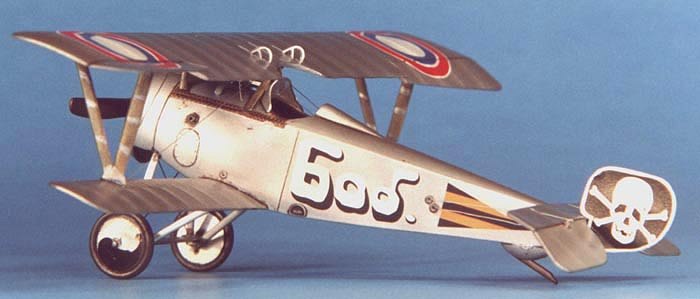
Eduard 1/48 Nieuport N 23
|
KIT # |
8075 |
|
PRICE: |
$22.50 |
|
DECALS: |
Two versions |
|
REVIEWER |
|
|
NOTES: |
|

|
HISTORY |
The Nieuport 23 was one of the many successful variants of the famous Nieuport series single seat fighters built during WWI. Externally, the Nie23 looks virtually identical to its famous brother, the Nie17, and this causes great confusion in identifying them. This coupled with the fact that many Nie23ís were shipped with Nie17 components makes confirmed identification of this variant difficult. The main differences were in the engine, reinforced wing, and synchronization gear for the machine gun, with the Nie23 having an upgraded 120-HP Le Rhone 9Jb and the machine gun mounting location moved offset slightly to the starboard side for most (but not all!) aircraft. The Nie23 was built in Russia by the Dux Company and continued flying with the Red Army until the mid-1920ís.
The aircraft modeled is one flown by Kpt. Brodovicz of the famous 19th (Death or Glory) Squadron of the Imperial Russian Air Force. There is some controversy as to whether this aircraft is in reality a Nie17, but I chose to model it as a Nie23 since I already have a ton of Nie17ís! From the photoís I have seen of the aircraft it is difficult to tell for sure, although the modified rigging scheme may indicate the reinforced wings of the Nie23. At any rate, how could I not build a model that has my name "Bob" emblazoned on the side! Reportedly, "Bob" is a Russian nickname for Boris.
|
THE KIT |
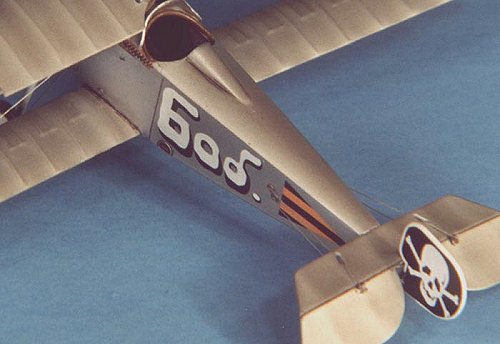 This kit
represents Eduardís evolution from a small, limited run modeling company to a
major player in the business, and the only modern modeling company who places an
emphasis on my favorite subject; WW I aircraft. Those familiar with Eduardís
earlier products remember poorly molded limited run injection molding with
little (if any) engraved detail and extremely poor fitting parts (better start
with a fresh tube of putty was my motto!). Well, not any more! This kit contains
two finely molded sprues of injected plastic (48 items) that rivals any Japanese
kit in quality and detail, a clear injected windscreen, and a decal sheet that
provides for two different aircraft. The instruction sheet consists of 8 pages
and clearly indicates which parts and decals are needed for the specific
aircraft you are building. It includes a color selection chart with cross
references for five paint manufacturers and a parts map for the kit.
This kit
represents Eduardís evolution from a small, limited run modeling company to a
major player in the business, and the only modern modeling company who places an
emphasis on my favorite subject; WW I aircraft. Those familiar with Eduardís
earlier products remember poorly molded limited run injection molding with
little (if any) engraved detail and extremely poor fitting parts (better start
with a fresh tube of putty was my motto!). Well, not any more! This kit contains
two finely molded sprues of injected plastic (48 items) that rivals any Japanese
kit in quality and detail, a clear injected windscreen, and a decal sheet that
provides for two different aircraft. The instruction sheet consists of 8 pages
and clearly indicates which parts and decals are needed for the specific
aircraft you are building. It includes a color selection chart with cross
references for five paint manufacturers and a parts map for the kit.
|
CONSTRUCTION |
This was a straight out-of-the-box build (OOB) of the kit since it is highly accurate and no additional parts are really necessary to produce a quality model. I started with my usual warm, dish soap water wash of the plastic and followed with a cold water rinse. Pat dry with a paper towel and let dry overnight. In order to add some animation to the model, the ailerons and elevators were removed and glued back on with liquid cement. I then pre-painted all the parts as indicated in the instructions. The stringer detail on the fuselage sidewalls were then hand painted Testors Model Master (TMM) French Chestnut and given a light wash of burnt umber.
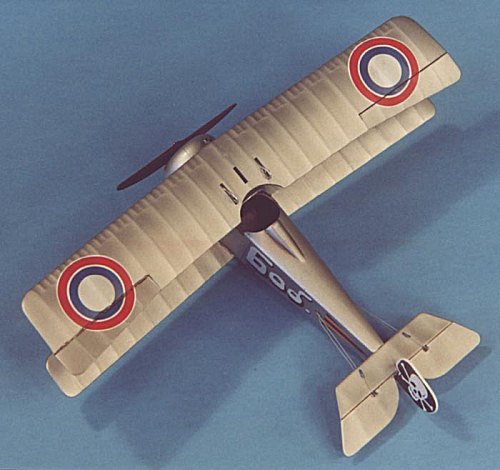 Assembly
of the fuselage components was accomplished using super-thin superglue. Do
yourself a favor and do not cut out the insert shown in step 1, just trim the
machine gun mount (A25) shorter to fit. Assembly proceeded as described in the
instructions, with no major problems. I then closed up the fuselage with liquid
cement and started on the engine components. I added the intake manifolds to
each cylinder with .025 non-lead fly fishing wire. The cowl for "Bob"
needs to have an additional portion removed; that was quickly accomplished with
a mini-riffler file. Next, I glued with liquid cement the tail fin, the
horizontal stabilizer, and lower wing to the fuselage. All joins were then
sanded smooth, and putty was used to fill some minor gaps in the lower wing to
fuselage join. Then I drilled all of the rigging holes as described in the
instructions. Next stop was the paint shop after stuffing the cockpit opening
and cowl with tissue paper to prevent overspray.
Assembly
of the fuselage components was accomplished using super-thin superglue. Do
yourself a favor and do not cut out the insert shown in step 1, just trim the
machine gun mount (A25) shorter to fit. Assembly proceeded as described in the
instructions, with no major problems. I then closed up the fuselage with liquid
cement and started on the engine components. I added the intake manifolds to
each cylinder with .025 non-lead fly fishing wire. The cowl for "Bob"
needs to have an additional portion removed; that was quickly accomplished with
a mini-riffler file. Next, I glued with liquid cement the tail fin, the
horizontal stabilizer, and lower wing to the fuselage. All joins were then
sanded smooth, and putty was used to fill some minor gaps in the lower wing to
fuselage join. Then I drilled all of the rigging holes as described in the
instructions. Next stop was the paint shop after stuffing the cockpit opening
and cowl with tissue paper to prevent overspray.
The model was painted, decaled, and weathered as described in the following subsections and then final assembly took place.
I installed the interplane and cabane struts into place using relatively large amounts of super-thin superglue. This is done to insure a relatively fragile model does not explode in later life! The cabane struts were glued to the fuselage body in correct spacing for the upper wing using a caliper to exactly set the distance and the interplane struts were glued to the bottom of the top wing. Basically, by applying small drops of super-thin superglue carefully around the strut to form a small bead around the strut base you can make the model much stronger. Do not use an excessive amount, just enough for a thin bead.
Now it was time to work on the machine gun. Assemble the gun as shown in the instructions. After drilling out the gun barrel, I painted the machine gun in Testors Metallizer Gun Metal and dry brushed with Floquil Gun Metal.
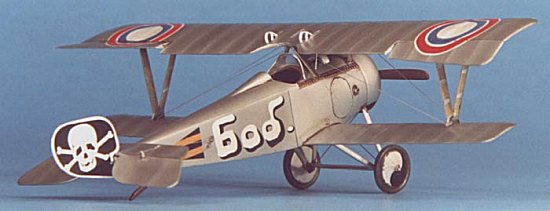 Now onto
the fun part, putting on the top wing! Actually, this task went smoothly with no
problems. Since the cabane struts are already fixed in the correct position on
the fuselage (using a caliper to set the actual distance) the top wing snapped
into place in the correct position. I placed the upper wing on the work bench
and turned the fuselage upside down to mount it. First set the interplane struts
into place in their correct holes, then flex the cabane struts into their
respective holes and bingo, the wing is in place. I used small rubber bands to
help hold both wings in place and then checked alignment of the top to bottom
wing. When all was to my liking, superglue the struts to wing using the bead
technique described above. A word of caution, let the glue cure fully before
moving the model and you will be rewarded with a relatively strong top wing
join. I do not use an accelerant for the superglue as it discolors and sometimes
pits the surface.
Now onto
the fun part, putting on the top wing! Actually, this task went smoothly with no
problems. Since the cabane struts are already fixed in the correct position on
the fuselage (using a caliper to set the actual distance) the top wing snapped
into place in the correct position. I placed the upper wing on the work bench
and turned the fuselage upside down to mount it. First set the interplane struts
into place in their correct holes, then flex the cabane struts into their
respective holes and bingo, the wing is in place. I used small rubber bands to
help hold both wings in place and then checked alignment of the top to bottom
wing. When all was to my liking, superglue the struts to wing using the bead
technique described above. A word of caution, let the glue cure fully before
moving the model and you will be rewarded with a relatively strong top wing
join. I do not use an accelerant for the superglue as it discolors and sometimes
pits the surface.
Now on to the next challenge, installing the landing gear! Installing landing gear on Eduard WW I models is a challenge at best and extremely frustrating at worst. I use a simple method in that I build a jig. My jig is nothing but a small block of Styrofoam packing material that comes in protective packaging of electronics goods. One TV and you are set for life! Take a small block of Styrofoam and mark the width of the landing gear on it. Carefully measure all dimensions and mark them on the block to maintain the correct angles. Push the legs of the landing gear into the block and set the approximate width of the landing gear axle. Then place the axle into place on the legs and after carefully aligning everything glue it in place. Let the glue fully cure then paint the assembly, let dry, and remove it from the block. Glue one leg into place with superglue, let set, then glue the remaining legs into place. Use the superglue bead technique described for the struts and you will be rewarded with a relatively strong set of landing gear. Lastly install the wheels into place on the axle with superglue, and the tailskid.
I substituted hard metal wire for the horizontal stabilizer
bracing as cleaning the mold lines and sprue points of the provided plastic
pieces would have been much harder. Carefully install the propeller with
superglue and prepare for the next fun job of rigging a WWI biplane! Truthfully,
rigging an airplane is not difficult. It is time consuming and tedious.
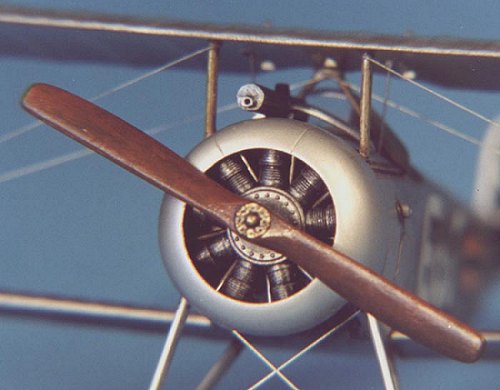 First you need a plan. You should
have a rigging plan in place before you even start construction of the model so
you can pre-drill holes and plan for obstruction problems. Study the
instructions carefully and figure out where every rigging wire needs to go. Each
kit will be different and will have a different plan. I no longer drill holes
through struts for rigging as it may pull out in time. I wrap the end of the
wire completely around the strut and secure it with a tiny drop of extra thin
superglue using the bead technique described for struts. Rig the rest of the
model as indicated on the instruction sheet. Note that the rigging diagram shown
in the instructions is incorrect for "Bob". Pictures of
"Bob" show a simplified rigging scheme with only rigging wires running
from the base of the interplane struts to the top of the cabane struts. The aft
end and landing gear rigging instructions are correct.
First you need a plan. You should
have a rigging plan in place before you even start construction of the model so
you can pre-drill holes and plan for obstruction problems. Study the
instructions carefully and figure out where every rigging wire needs to go. Each
kit will be different and will have a different plan. I no longer drill holes
through struts for rigging as it may pull out in time. I wrap the end of the
wire completely around the strut and secure it with a tiny drop of extra thin
superglue using the bead technique described for struts. Rig the rest of the
model as indicated on the instruction sheet. Note that the rigging diagram shown
in the instructions is incorrect for "Bob". Pictures of
"Bob" show a simplified rigging scheme with only rigging wires running
from the base of the interplane struts to the top of the cabane struts. The aft
end and landing gear rigging instructions are correct.
For rigging wire I use fly fishing leader material that is .006 inches in diameter. It is easy to use, just paint it whatever color you like (I finally found a use for those Testors paint markers that I bought! Flat black is best for appearance, silver is the more realistic color but doesnít show up well on pictures), is easy to pull taut (use a hemostat as that vital third hand to keep the wire taut), is easy to thread around/through stuff, and more importantly, you can trim it flush easily with a new XACTO blade. No more metal wire or stretched sprue for me!
Finally, the model is almost done. The last step is to install the remaining parts to the upper wing.
|
PAINT & DECALS |
The model was very easy to paint since the entire scheme is in silver. Since I was planning on using Metalizer paints, I first shot a light coat of Future over the entire model. The Future provides a better surface for adhering and also helps hide any scratches in the surface so you do not have to polish the surface (a tedious and boring task in which I always manage to break something!). I airbrushed an 80:20 mix of Testors Metalizer Aluminum (non-buffing) and Dark Anodonic Gray to achieve a silver doped look on the wings and aft fuselage. Should have gone 60:40 as it ended up not being dark enough. After drying overnight, I masked off with Tamiya masking tape the rib tape lines on the aft fuselage and shot a coat of straight Aluminum for the these and the metal/wood portions of the aircraft. Masking on Metalizer, who would have thought you could do this? But you can with a Future base! Some finish will peel off with the tape and mar the finish, but simply buff with a clean soft cloth and you will buff out the imperfections.
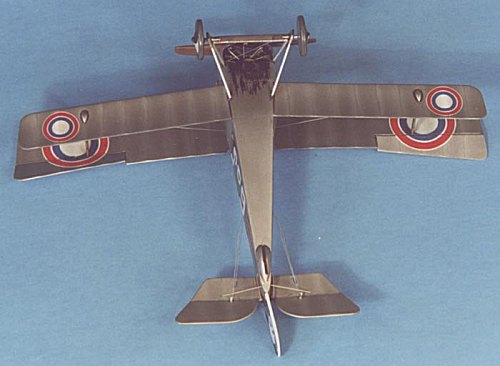 The kit
comes with decals for two different versions of aircraft, flown by the Imperial
Russian Air Force and by French pilot Corniglion-Molinier in Italy. The only
problem with the decals is that the Yin-Yang decals for the wheels are a bit too
small and should probably be painted on. After a short drying period of about an
hour, I applied MicroSol setting solution to get the decals to melt into the
surface. I repeated with a second coat of setting solution to get all the decals
fully down. They responded very well to the setting solution with no permanent
wrinkling. After drying overnight, I wiped the decals off with a moist cloth
with Polly S Plastic Prep to remove any residue and after drying I shot a very
light coat of Future thinned with rubbing alcohol (50:50 mix) over the decals to
seal them.
The kit
comes with decals for two different versions of aircraft, flown by the Imperial
Russian Air Force and by French pilot Corniglion-Molinier in Italy. The only
problem with the decals is that the Yin-Yang decals for the wheels are a bit too
small and should probably be painted on. After a short drying period of about an
hour, I applied MicroSol setting solution to get the decals to melt into the
surface. I repeated with a second coat of setting solution to get all the decals
fully down. They responded very well to the setting solution with no permanent
wrinkling. After drying overnight, I wiped the decals off with a moist cloth
with Polly S Plastic Prep to remove any residue and after drying I shot a very
light coat of Future thinned with rubbing alcohol (50:50 mix) over the decals to
seal them.
For weathering, I chose to accentuate the engraved panel lines and surface detail with a light black oil wash. Next, a light coat of Polly S Flat Finish was shot to provide a surface for pastels. I then used pastels, pastel pencils, and watercolor pencils to lightly highlight the ribs and detail on the wings/tail surfaces and fuselage. I use Derwent pastels and pencils and they are quite easy to use, just lightly draw on the surface to be highlighted and blend with artists blending stump. A very nice, subtle effect can be achieved with these pencils that is much easier for me than dry brushing. A close look at the detail shot of the aft fuselage shows this subtle highlighting really well. Lastly, I applied a heavy burnt umber oil wash to the wheels and control surface joins.
I then finished final assembly of the models as described above. Lastly, I lightly touched up by hand painting with the appropriate colored paints all flaws and the areas that were covered in superglue including strut/rigging attachment points. Next was a technique I learned that helps hide minor flaws in a model finish caused by superglue and painting successive coats. It is very simple, just spray the entire model with several coats of a mix of equal parts Future, Tamiya Flat Base (X21), and rubbing alcohol. This will hide almost all minor flaws in the finish, but will not cover major flaws so it is not a substitute for poor modeling technique. Finally, several coats of Polly S Satin Finish was shot to achieve the semi-gloss finish common to most WWI aircraft. Now, drink a favorite beverage and admire your good work!
|
CONCLUSIONS |
This is an excellent model of an important WW I aircraft. Overall the quality and accuracy are exceptional. The level of detail engraved in the kit is a great improvement over previous generation Eduard models, and no after-market sets are really needed for a beautiful build. I highly recommend this kit for all levels of builders including beginners and I enjoyed the building of this model. For those modelers that have built Eduard kits in the past and swore them off due to the poor fit and construction problems, this model will definitely change your opinion. This is an excellent kit for beginners or first time WW I modelers.
|
REFERENCES |
Squadron/Signal Publications, Nieuport Fighters In Action, SS1167, $8.95
Flying Machines Press, French Aircraft of the First World War, $90.00
Albatros Productions LTD, Windsock Datafile, Nieuport Fighters, $23.00
Copyright ModelingMadness.com. All rights reserved. No reproduction in part or in whole without express permission from the editor.
If you would like your product reviewed fairly and fairly quickly, pleasecontact the editor or see other details in the Note to Contributors.
Back to Reviews Page 2024